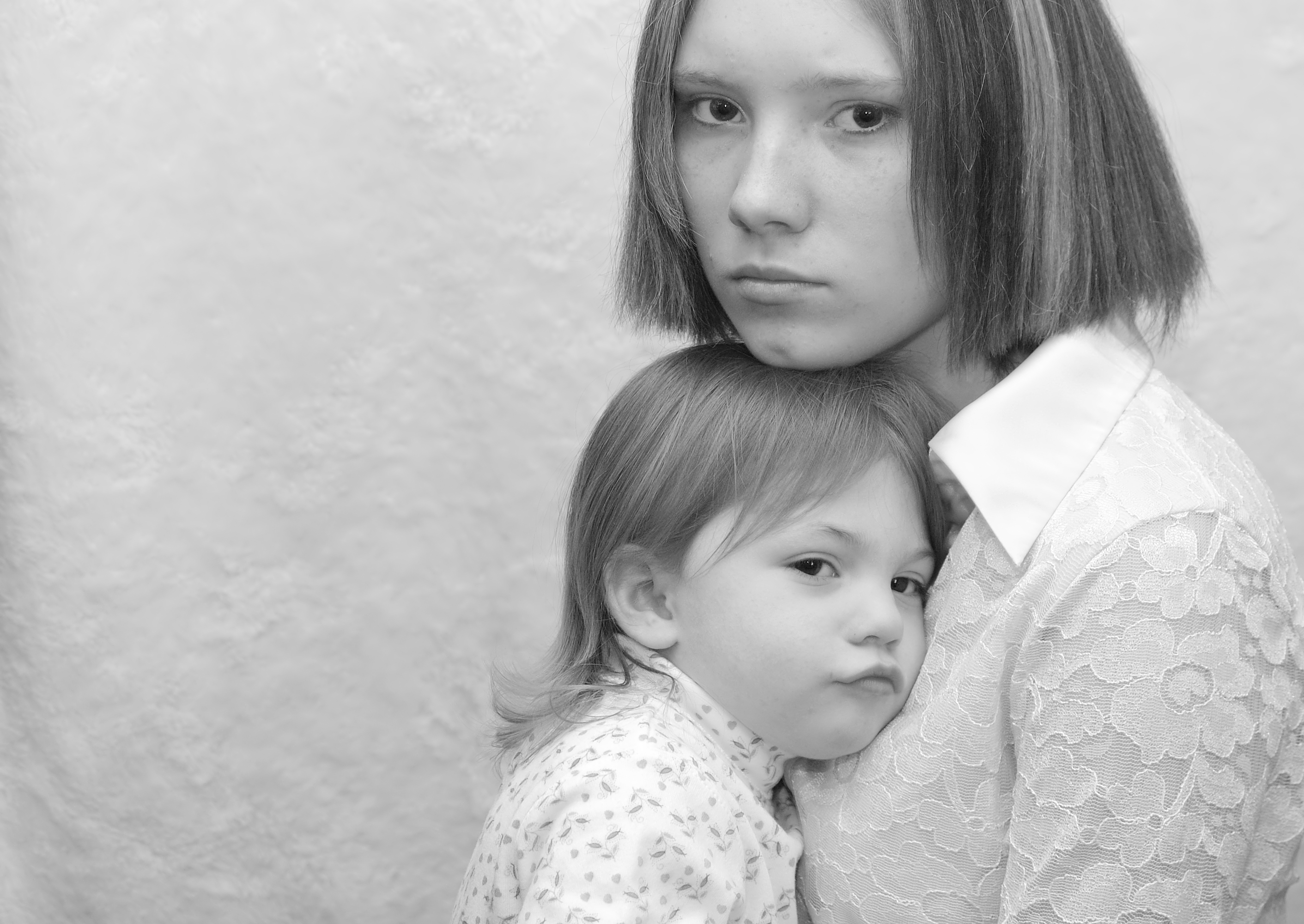|

In one of my workshops, a woman told me about the day when, at the age of five, she was told her
mother had died. "Where is my mother?" she had asked a neighbor.
"She's in heaven with God," came the answer.
In our workshop session, this woman had taken a black crayon and drawn a heavy line across her sheet of
paper. Above the line she put two stick figures. At the bottom of the page she drew another, smaller stick figure. "That's
my mother at the top, with God," she said. "I'm the one on the bottom. From the time I was five I felt all alone, cut off
from my mother and God."

I kept the woman's drawing as a reminder that our answers to children's questions about death
may be barely grasped, but more deeply felt than words can tell. What parent wants to talk
with a child about death? So much of a child's beauty is in the boundless energy that seems sure to live forever. Yet from
their earliest days -- with each experience of loss, big and small, from the fall of night outside the bedroom window to the
passing of a loved one -- children come to know something about death.
Some of the most popular games of early childhood began as playful attempts to cope with the reality
of death. Hide-and-seek, for example, originally included chanting and music that suggest the game was about running away
from death. The words "Abracadabra!" were supposed to magically prevent the plague. In contemporary Mexico on the Dia de los
Muertos, children eat candy skulls and buy paper skeletons and low them apart with firecrackers. Today in our culture, kids
still play cops and robbers shouting, "Bang, bang, you're dead."
And they ask questions. How long will the cut flowers on the kitchen table last? What happens
when apples fall off a tree? Why did our pet die? "Mommy, what's a deathbed?" asked a seven-year-old after reading a fairy
tale, uneasily eying her blankets and pillow. From weaning to the first day of kindergarten
to going off to camp, children learn to cope with loss.
Why did Grandpa die?
Death and Development
Long before children know the word death, they are learning to cope with absence, loss, and the
idea of nonbeing. Toddlers finish their cereal and announce, "All gone!" They are willing to endlessly practice blowing out
a match and turning lights on and off, not to mention flushing household items down the toilet. "Barbie's a girl, so she dies
last," observed one five-year-old as she let her Ken doll topple to the floor. "Women live longer than men."
As the psychologist Robert Kastenbaum wrote in The Psychology of Death, "thoughts about
death are intertwined with the total pattern of personality development right from the beginning, influencing and being influenced
by all the child's experiences."
Some of the most influential research about children's understanding of death was published in
1948 by the clinical psychologist Maria Nagy, who found that children under five years of
age tended to think of death as a reversible process, like sleep. A parent who goes out to
the movies may seem, to a young child, to have totally disappeared. A person who dies on the other hand, may "wake up" any
moment, like Sleeping Beauty. "At funerals you're not allowed to sing," one four-year-old explained to Nagy, "because otherwise
the dead person couldn't sleep peacefully." A child this age may try to make a dead bird fly, or put a fallen leaf back on
a tree.
When John F. Kennedy's son John returned on a visit to the White House after his father's death,
writes Earl Grollman in Talking About Death, he asked, "When is my Daddy coming back?"
A young child's confusion is not surprising, because the difference between dead and alive
is fuzzier than we tend to think. In his interesting study, Philosophy and the Young Child, Gareth B. Mathews struggles
to answer five-year-old David, who is wondering whether an apple is alive. If not, the child asks, how is the apple different
from the fruit when it's still on the tree? And what about an apple on the ground, which may eventually sprout seeds for a
new tree? Mathews suggests that death occurs when the cycle is interrupted -- say, when the sapling withers so that it will
not grow into a tree or when the apple is brought indoors so that its seeds will not germinate. He also talks with six-year-old
John who, shortly after the death of the family dog, reflects on the fact that he himself has arms, legs, and a head, and
wonders, "Which part of me is really me?" The child, who knows that his toenails can get clipped or his hair cut, tries to
figure out if there is any part of him that he can't lose without ceasing to exist.
Between five and nine, children begin to understand that death is permanent. Now death is often personified as a skeleton-man or monster (like the Grim Reaper), or as a kidnapper who steals
away people during the night. Children at this age are less likely to express their fears about death. Instead they focus
on trying to avoid it, like the "cooties." They can sound startlingly callous. One mother brought her six-year-old son to
a party at a nursing home. The boy looked around and visibly shuddered. "We're the only people here not in wheelchairs, Mom,"
he said. "Let's get out of here."
If a person in the family or community dies, children at this age need reassurance: "Since Daddy
has gray hair, is he going to die, too? When you get sick will you die, too?"
Why did my friend die? Why am I sick? If I promise to be good all the time, will God make me better?
Healthy grief is a healing process. Through our pain and sadness and the disruption of our daily routine,
we come to accept the loss of a loved one and to treasure his memory. In his famous studies
at London's Tavistock Clinic, John Bowlby found that the child's natural grieving process has three phases: disbelief,
with protests and insistence that the person will come back; coming to terms with the painful reality that the
loved one is really gone (a stage when the child is likely to regress to more immature behavior); and finally hope, when
the child gets back to his everyday routine and life goes on.
Infants, toddlers, and preschoolers may be cranky, unusually demanding, or clingy as they grieve. Their sleeping and eating patterns are often irregular.
They may play out their feelings of loss by setting up pretend funerals or death scenes with toys and blocks. Because they
lack a real understanding of death, they are often impatient: "Hasn't he been dead enough?"
School-age children may
be shocked, fearful, and anxious about loved ones who are still alive. "Are you going to die, too?"
The adolescent is
likely to feel strongly how unfair it is that people die, and yet to believe that it will never happen to him. Because he
sees himself as invincible, a death in the adolescent's immediate circle of friends hits hard. He can begin to grapple with
the philosophical reality of death through literature and by actively participating in commemorative activities -- a memorial
service, for example, or a scholarship fund. But he needs caring adults who are willing to listen, no matter how angry or
cynical he sounds.
What happens to people after they die? Is heaven real?
The way you inform your child about a death can help her grieve in a healthy way. Before you talk
with your child, try to find time to share your own feelings with a friend or family member. Ten choose a familiar, comfortable
place to talk with your child. Sit down and tell her what has happened. Speak clearly and simply. "I have some sad news to
tell you. You know that Grandpa hasn't been doing very well for a long time now. Well, he died last night." If the death is
sudden, express your own surprise. "Something terrible has happened, something nobody expected. Aunt Sarah was hit by a car
yesterday. The doctors worked hard to save her, but they couldn't. She died." If a death is sudden or violent, be prepared
for a great deal of anger. Be sure to mention that although you have some special things to do (make funeral arrangements,
bake casseroles for the immediate family, etc.), you are going to be sure to set aside time for your child. Tell her you think
it is very important to be able to talk about how she feels, and that if she thinks of questions to ask over the next few
days you will try to answer them. (Watch for signs that your child is having an especially difficult time. If she is unusually
quiet, unwilling to go out, frequently distracted, or preoccupied with morbid stories -- or if she doesn't return to her regular
routine after a few weeks -- it may be wise to seek professional help. Ask your child's pediatrician or school psychologist
for a referral.)
It's not helpful to overwhelm your child with your feelings, but avoid shutting her out by keeping
a "stiff upper lip." Try to find a balance. When you talk over a loss, gently encourage your child to express his feelings.
"I bet you're missing Grandpa a lot now that he's gone," you might say. Then share a memory of your own. "I miss him. Right
about now he'd have been setting out the tomato plants." Exposing your child to an overwhelming display of emotion can be
upsetting, but seeing your sadness and tears lets her know she can express her own feelings.
Excerpt from Small Wonder: How to Answer Your Child's Impossible Questions About Life (Penguin), (c) 1994 by Jean G. Fitzpatrick. All rights reserved.

|

